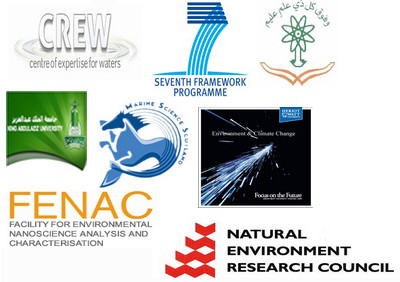I am interested in ecophysiology & ecotoxicology of near-shelf deep-sea organisms, the general ecophysiology of benthic organisms, the effects of anthropogenic activity on community structure and the fate of organic and inorganic pollutants in the marine and estuarine environment. Recent research activity has focused on sediment-associated organotin compounds and oilfield chemicals, bioaccumulation capacity of clams for metals and importance of exposure history, the potential impact of manufactured nanoparticles and microplastic contamination on the marine environment, as well as the effect of climate change on ecotoxicological biomarkers of contaminant exposure and effect. My current research projects are focussed on the impacts of deep-sea mining, nanomaterials and microplastics in the marine environment.
Current Projects
Towards a baseline database for microplastics in Scottish intertidal sediments
SMARTEX – Seabed Mining And Resilience To EXperimental impact
Completed Projects
Effects of noise as a multiple stressor in ecotoxicology
Ecotoxicological impact of high-aspect ratio nanomaterials in the marine environment.
Impact of engineered silver nanoparticles on microbial communities in estuarine sediments.
Funding
The combined impacts of climate change induced environmental variation and pollutant mixtures on stress response in typical estuarine invertebrate species.
Investigating the ecotoxicological effects of simulated salinity and temperature fluctuations in the presence/absence of environmentally relevant pollutant mixtures.
SMARTEX
Co-Investigator on SMARTEX: Seabed Mining And Resilience To EXperimental impact; £3.2m NERC funded consortium. Dr Hartl is the ecotoxicology lead.
Read more.
Effects of noise as a multiple stressor in ecotoxicology
Working towards assessing biomarker responses in invertebrates exposed to common environmental contaminants and noise.
Towards a baseline database for microplastics in Scottish intertidal sediments
There is a growing need to provide the Scottish Government with temporal and quantitative data to assess the impact of the Marine Litter Strategy policies design to reduce the amount of plastic debris and microplastic contamination in Scottish waters.
See case study in the Marine Scotland Assessment 2020.
Climate change and ecotoxicology: re-assessing biomarker baselines in light of a changing environment
Biomarkers, loosely defined as measurable effects providing evidence of exposure, are often used to assess effects following exposure to single or multiple stressors and ideally allow the establishment of causality. Biomarker studies are widely used in the assessment of environmental quality since they provide the necessary data to inform management decisions. Despite the increasing importance of cell lines and the development of in vitro co-culture models in routine toxicity testing, the use of whole organism exposure models still deliver ecotoxicological information, such as condition, growth, fecundity and population dynamics, that the former cannot, especially where new and emerging contaminants are concerned. Whole animal ecotoxicology studies should therefore be part of an integrated, appropriately regulated and licenced biomarker study. Indeed in vivo whole animal studies are required for regulatory purposes but the endpoints are often limited to mortality and reproduction.
Alas, single biomarkers in isolation are rarely sufficient to establish causality. Instead a suite of biomarkers on various levels of biological organisation is applied, giving rise to a biomarker profile that can be correlated with specific substances or substance classes. However, this requires intimate knowledge of the species in question and the relevant environmental variables, including how these may influence the respective biomarkers. The latest IPCC reports on climate change show that the upper 75m of the world’s oceans have been warming at a rate of 0.11°C per decade since at least 1971 and the uptake of anthropogenic CO2 has depressed pH by -0.0014 to -0.0024 per year. Climate change and associated changes to environmental physicochemical parameters, such as temperature rise, quality and quantity of particulate matter owing to increased erosion and runoff, ocean acidification etc., will affect ecotoxicology on several levels: first of all it will affect the distribution of many species. This could mean that well characterized marine taxa will no longer be available as sentinel species in given locations, because they will either start to migrate North, especially where they are already at their maximum thermal tolerance, or will disappear completely where this avoidance behaviour is not possible. Therefore, the disappearance of naturally occurring populations of established indicator species will need to be taken into account when interpreting relevant data obtained by applying these species in surveys (e.g. by deploying in cages) under the changed conditions. Ocean acidification, the drop of pH in seawater through uptake of anthropogenic CO2, will affect the behaviour and fate of contaminants because of the relationship between pH and charge. This will have a major effect on bioavailability of contaminants and also on how different contaminants interact with each other, altering their respective toxicities. Climate change-related shifts in salinity, either from increased evaporation in tropical oceans, or increased precipitation in mid to high latitudes, are also known to influence chemical contaminants and modulate their fate and bioavailability. Thirdly, endpoint (biomarker) results (toxicity) can be altered by environmental variables, such as temperature, salinity, pH, etc. This will be particularly relevant for membrane-bound processes that rely on certain cell and organelle membrane characteristics and integrity, such as fluidity and permeability. Furthermore, assays measuring the activity of key antioxidant and other detoxification systems can be influenced by salinity, whilst others appear unaffected.
The evidence for anthropogenically-driven climate change is overwhelming and it is clear that it is affecting habitats for marine organisms. Nevertheless, there is a growing realization that some established biomarker species and endpoints may need to be re-evaluated if they are to be used in future and adapted accordingly in order to ensure meaningful results in a changing environment.
Ecotoxicological impact of high-aspect ratio nanomaterials in the marine environment.
Ecotoxicology of sediment-associated carbon nanotubes
FP7 Nanosolutions: providing a means to develop a safety classification for engineered nanomaterials (ENM) based on an understanding of their interactions with living organisms at molecular, cellular and organism levels.
Read more…
FP7 ITSNANO: Towards intelligent testing strategies for engineered nanomaterials. Read more….
Impact of engineered silver nanoparticles on microbial communities in estuarine sediments.
